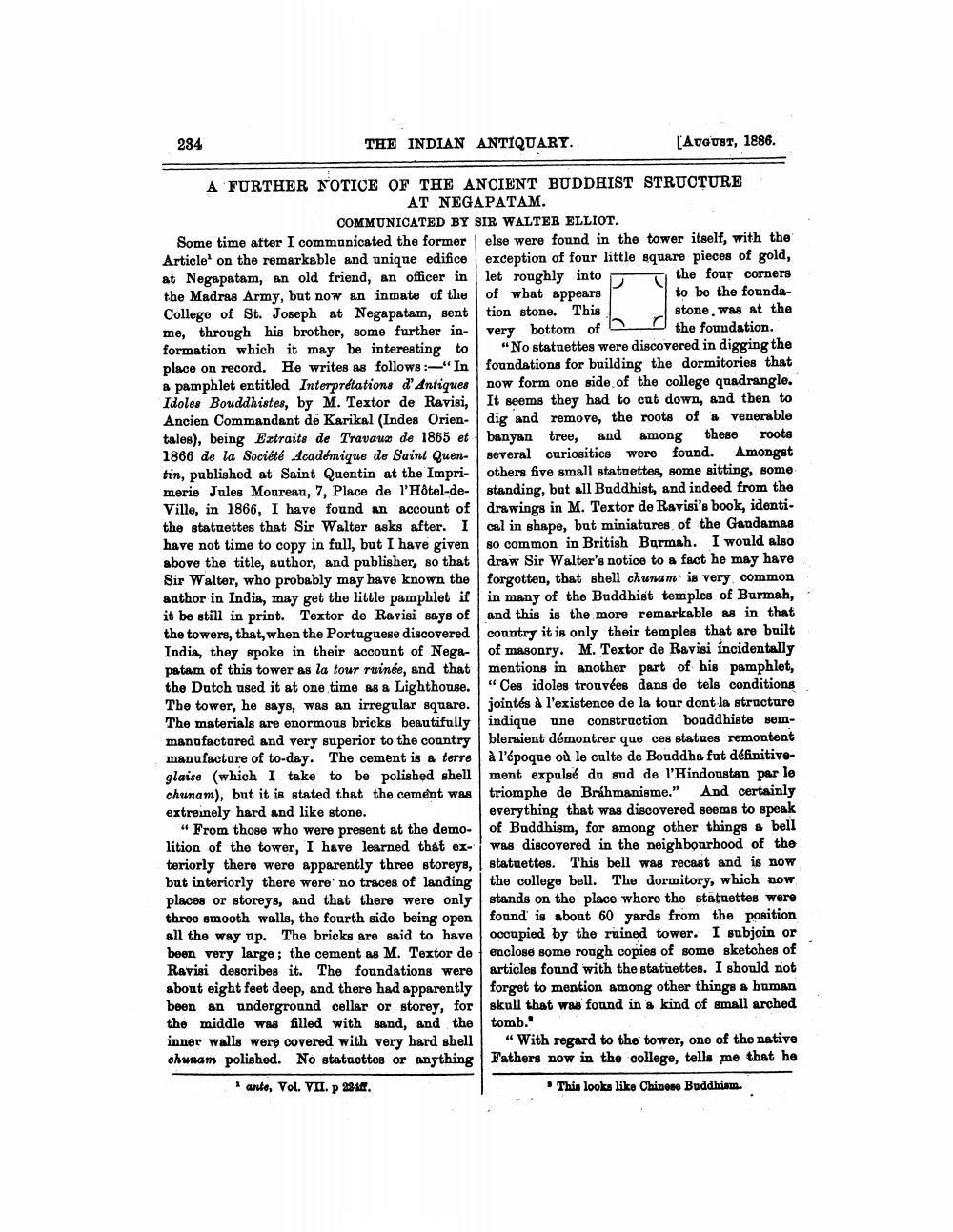________________
284
THE INDIAN ANTIQUARY.
[August, 1886.
A FURTHER NOTICE OF THE ANCIENT BUDDHIST STRUCTURE
AT NEGAPATAM.
COMMUNICATED BY SIR WALTER ELLIOT. Some time after I communicated the former else were found in the tower itself, with the Article on the remarkable and unique edifice exception of four little square pieces of gold, at Negapatam, an old friend, an officer in let roughly into ū the four corners the Madras Army, but now an inmate of the of what appears
to be the foundaCollege of St. Joseph at Negapatam, senttion stone. This
stone, was at the me, through his brother, some further in- very bottom of
the foundation. formation which it may be interesting to "No statuettes were discovered in digging the place on record. He writes as follows:-"In foundations for building the dormitories that a pamphlet entitled Interprétations d'Antiques now form one side of the college quadrangle. Idoles Bouddhistes, by M. Textor de Ravisi, It seems they had to cut down, and then to Ancien Commandant de Karikal (Indes Orien- dig and remove, the roots of a venerable tales), being Extraits de Travaux de 1865 et banyan tree, and among these roots 1866 de la Société Académique de Saint Quen- several curiosities were found. Amongst tin, published at Saint Quentin at the Impri- others five small statuettes, some sitting, some merie Jules Moureau, 7, Place de l'Hôtel-de- standing, but all Buddhist, and indeed from the Ville, in 1866, I have found an account of drawings in M. Textor de Ravisi's book, identi. the statuettes that Sir Walter asks after. I cal in shape, but miniatures of the Gandamas have not time to copy in full, but I have given so common in British Barmah. I would also above the title, author, and publisher, so that draw Sir Walter's notice to a fact he may have Sir Walter, who probably may have known the forgotten, that shell chunam is very common author in India, may get the little pamphlet if in many of the Buddhist temples of Burmah, it be still in print. Textor de Ravisi says of and this is the more remarkable as in that the towers, that, when the Portuguese discovered | country it is only their temples that are built India, they spoke in their account of Nega- of masonry. M. Textor de Ravisi incidentally patam of this tower as la tour ruinée, and that mentions in another part of his pamphlet, the Dutch used it at one time as a Lighthouse. “Ces idoles trouvées dans de tels conditions The tower, he says, was an irregular square. jointés à l'existence de la tour dont la structure The materials are enormous bricks beautifully indique une construction bouddhiste semmanufactured and very superior to the country bleraient démontrer que ces statues remontent manufacture of to-day. The cement is a terre à l'époque où le culte de Bouddha fut définitiveglaise (which I take to be polished shell ment expulsé du sud de l'Hindoustan par le chunam), but it is stated that the cement was triomphe de Brahmanisme." And certainly extreinely hard and like stone.
everything that was discovered seems to speak "From those who were present at the demo- of Buddhism, for among other things & bell lition of the tower, I have learned that ex- was discovered in the neighbourhood of the teriorly there were apparently three storeys, statuettes. This bell was recast and is now but interiorly there were no traces of landing the college bell. The dormitory, which now places or storeys, and that there were only stands on the place where the statuettes were three smooth walls, the fourth side being open found' is about 60 yards from the position all the way up. The bricks are said to have oocupied by the rained tower. I subjoin or been very large; the cement as M. Textor de enclose some rough copies of some sketches of Ravisi describes it. The foundations were articles found with the statuettes. I should not about eight feet deep, and there had apparently | forget to mention among other things a human been an underground cellar or storey, for skull that was found in a kind of small arched the middle was filled with sand, and the tomb." inner walls were covered with very hard shell “With regard to the tower, one of the native chunam polished. No statuettes or anything Fathers now in the college, tells me that he ante, Vol. VII. p 2244.
• This looks like Chinese Buddhism.




